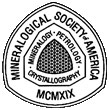 | The Mineral Identification Key |  |
 | The Mineral Identification Key |  |
Mineral Environments & Associations
Where a mineral is found – the type of rock in which it is found – and with what it is found – the other minerals that occur with it – can be as important to identifying the mineral as its physical properties. While there is not room for much of this information in the Key, the collector should pay close attention to it when they encounter it in field guides or other reference works.
Mineral Environments refers to the "geologic environments" in which minerals occur – the types of rocks in which they are found. While some minerals occur in two or more environments, others tend to be restricted to a single environment. If you think you have found the mineral kyanite in a sedimentary sandstone and see that it is a mineral formed by metamorphic processes you’ll know it can’t be kyanite. Try celestite… If you think you have found topaz in a cavity in basalt and read that it is largely restricted to pegmatite you’ll know it isn’t topaz. And so on.
On a smaller scale, environments can vary over the volume of a single deposit. A lode of copper ores may have an oxidized zone (gossan) , a supergene enriched zone, and a deep primary zone. Each zone tends to produce distinct mineral assemblages. And figuring out in which zone a mineral formed leads to learning about mineral associations.
Mineral Associations are simply that – what minerals occur with one another in what environments. Such as minerals like malachite and brochantite most often being found with chalcopyrite and pyrite. Or secondary phosphate minerals being associated with triphyllite or lithiophilite. If you think you’ve found vivianite in a pegmatite, but there is no triphyllite around, maybe that isn’t what you have…
So it is always a good idea to pay attention to environmental information and any associations described. Sometimes an identification can be nailed down with that information – or one or more likely suspects eliminated by it. As stated above, this information is as important as the physical properties of the minerals themselves.
Information about the minerals that have been found at a particular location is often available either on the web, in various "hobby" publications, the scientific literature, and in publications from the various state and national (United States) geological surveys. These mineral lists often contain descriptions of the mineral habits found at a locality, and can be an invaluable help in determining what mineral(s) you have. This is another reason why good record keeping about the locality where a specimen is from is extremely helpful.
[ Table of Contents ] [ Introduction ] [ Identification Kit ] [ Mineral Properties ] [ Environments & Associations ] [ In Conclusion ] [ The Mineral ID Key ]